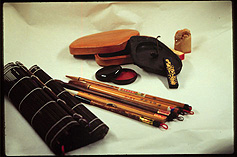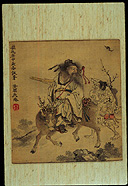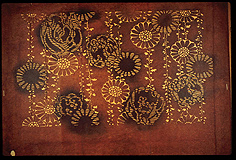The Heian period refers to the years between 704 and 1185. The period is further divided into the early Heian and the late Heian, or Fujiwara periods.
In the Fujiwara period, Pure Land Buddhism became popular. There are six paintings from the period that I would like to introduce. The paintings are: (1) Senzui Byobu; (2) Shaka Nyorai; (3) Twelve Devas; (4) Kofuku-ji Mandala; (5) Amida Coming over the Mountain and (6) Raigo of Amida and Twenty-five Attendants. The paintings can all be found in Kyoto National Museum, Japan.

SENZUI BYOBU (Landscape with Figures Screen)
Six-fold screen, color on silk, Each 146.4 x 42.7 cm, Late-Heian Period (11th Century)
Senzui-byobu is a type of screen painting used in the ordination ceremonies of the Shingon sect of Esoteric Buddhism. Such screens seem to have been adapted from those used in the residences of Heian nobility.
Click here to see more
Senzui Byobu
SHAKA NYORAI (Sakya Tathagata)
Hanging scroll, color on silk, Proportions: 159.4 x 85.5 cm, Late Heian Period (12th Century)
This painting has been called Aka Shaka because of the color of the robes. Shakamuni sits cross-legged on the seven-fold lotus seat. His body is yellowish-white and outlined in flowing, red strokes. Shaka's robes are decorated with a shippo-tsunagi pattern in kirikane (cut gold leaf). Highlighted sections are colored white. The serene and elegant facial expression and the mild colors give this painting a sense of graceful serenity. It can be regarded as the finest depiction of a nyorai (Tathagata) of the Heian Period Buddhist paintings.
Click here to see more
Shaka Nyorai
 TWELVE DIVAS
Set of 12 hanging scrolls, Color and gold on silk, 144.2 x 126.6cm each, Late Heian Period (Dated 1127)
The Twelve Devas are the gods of the twelve directions in Esoteric Buddhism, including the four quarters and four semi-quarters, up and down, and the sun and moon, and are the guardians of Esoteric Buddhist monasteries. Each of the devas is seated on a felt pedestal with an attendant on either side. The flesh of compassionate devas is outlined in red, while those with angry and other expressions are contoured in black. Color gradation is used to gives the figures depth.
TWELVE DIVAS
Set of 12 hanging scrolls, Color and gold on silk, 144.2 x 126.6cm each, Late Heian Period (Dated 1127)
The Twelve Devas are the gods of the twelve directions in Esoteric Buddhism, including the four quarters and four semi-quarters, up and down, and the sun and moon, and are the guardians of Esoteric Buddhist monasteries. Each of the devas is seated on a felt pedestal with an attendant on either side. The flesh of compassionate devas is outlined in red, while those with angry and other expressions are contoured in black. Color gradation is used to gives the figures depth.
Click here to see more
Twelve Devas
KOFUKU-JI MANDALA
Hanging scroll, color on silk, Proportions: 96.8 x 38.8 cm, Kamakura Period (12th-13th Century)
This is one the Kasuga Shrine and Temple Mandalas that depict Kasuga Shrine and Kofuku-ji Temple. This painting is unusual, however, in that it portrays Kofuku-ji Temple as its primary subject. The work depicts Buddhist statues in ink on gold leaf, which adds appropriate brightness to the scene. Although minutely detailed, the overall painting style is magnificant and lavish.
Click here to see more
SENZUI BYOBU (Landscape with Figures Screen)
Six-fold screen, color on silk, Each 146.4 x 42.7 cm, Late-Heian Period (11th Century)
Senzui-byobu is a type of screen painting used in the ordination ceremonies of the Shingon sect of Esoteric Buddhism. Such screens seem to have been adapted from those used in the residences of Heian nobility.

SHAKA NYORAI (Sakya Tathagata)
Hanging scroll, color on silk, Proportions: 159.4 x 85.5 cm, Late Heian Period (12th Century)
This painting has been called Aka Shaka because of the color of the robes. Shakamuni sits cross-legged on the seven-fold lotus seat. His body is yellowish-white and outlined in flowing, red strokes. Shaka's robes are decorated with a shippo-tsunagi pattern in kirikane (cut gold leaf). Highlighted sections are colored white. The serene and elegant facial expression and the mild colors give this painting a sense of graceful serenity. It can be regarded as the finest depiction of a nyorai (Tathagata) of the Heian Period Buddhist paintings.
 TWELVE DIVAS
Set of 12 hanging scrolls, Color and gold on silk, 144.2 x 126.6cm each, Late Heian Period (Dated 1127)
The Twelve Devas are the gods of the twelve directions in Esoteric Buddhism, including the four quarters and four semi-quarters, up and down, and the sun and moon, and are the guardians of Esoteric Buddhist monasteries. Each of the devas is seated on a felt pedestal with an attendant on either side. The flesh of compassionate devas is outlined in red, while those with angry and other expressions are contoured in black. Color gradation is used to gives the figures depth.
TWELVE DIVAS
Set of 12 hanging scrolls, Color and gold on silk, 144.2 x 126.6cm each, Late Heian Period (Dated 1127)
The Twelve Devas are the gods of the twelve directions in Esoteric Buddhism, including the four quarters and four semi-quarters, up and down, and the sun and moon, and are the guardians of Esoteric Buddhist monasteries. Each of the devas is seated on a felt pedestal with an attendant on either side. The flesh of compassionate devas is outlined in red, while those with angry and other expressions are contoured in black. Color gradation is used to gives the figures depth.
KOFUKU-JI MANDALA
Hanging scroll, color on silk, Proportions: 96.8 x 38.8 cm, Kamakura Period (12th-13th Century)
This is one the Kasuga Shrine and Temple Mandalas that depict Kasuga Shrine and Kofuku-ji Temple. This painting is unusual, however, in that it portrays Kofuku-ji Temple as its primary subject. The work depicts Buddhist statues in ink on gold leaf, which adds appropriate brightness to the scene. Although minutely detailed, the overall painting style is magnificant and lavish.

 AMIDA COMING OVER THE MOUNTAIN
Hanging scroll, Color on silk, 120.6 x 80.3 cm, Kamakura Period (13th Century)
The painting shows the central image of Amida facing forward with both hands held over his breast. This pattern can be seen in the Zenrinji and Konkaikomyoji Amida Coming over the Mountain scrolls. In this scroll, however, Amida comes not over a mountain but across a valley, accompanied by six Bodhisattva attendants. He faces not forwards but to the left, with his right hand raised and his left hand down.
AMIDA COMING OVER THE MOUNTAIN
Hanging scroll, Color on silk, 120.6 x 80.3 cm, Kamakura Period (13th Century)
The painting shows the central image of Amida facing forward with both hands held over his breast. This pattern can be seen in the Zenrinji and Konkaikomyoji Amida Coming over the Mountain scrolls. In this scroll, however, Amida comes not over a mountain but across a valley, accompanied by six Bodhisattva attendants. He faces not forwards but to the left, with his right hand raised and his left hand down.